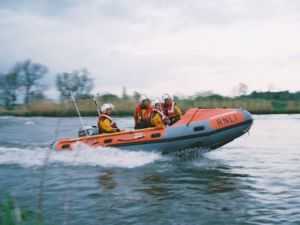D-class lifeboat (EA16)
 | |
| Class overview | |
|---|---|
| Builders: | Avon Inflatables |
| Operators: |
|
| Preceded by: | A class |
| Succeeded by: | IB1 |
| In service: | 1963–2006 |
| General characteristics | |
| Length: | 4.9 m (16 ft) |
| Propulsion: | 1 × Mariner outboard engine, 40 hp (30 kW) |
| Speed: | 20 knots (23 mph; 37 km/h) |
| Endurance: | 3 hours at full speed |
| Complement: | 3 or 4 |
The D class lifeboat EA16 is a class of inflatable boat formerly operated by the Royal National Lifeboat Institution of the United Kingdom and Ireland. It has been replaced by the D class lifeboat (IB1)
Utilization
For more than 40 years the D-class has served as the workhorse of the RNLI Inshore Lifeboat (ILB) fleet. Significantly smaller in comparison to the rest of the inshore fleet, the D-class is also one of the few RNLI types not to feature a rigid hull. The main aspect of the boat would be both its size and weight - only 436 kg (961 lb). The D-class has been specifically designed as a light and highly manoeuvrable rapid response craft.
Design and construction
The D-class lifeboat consists of two sponsons, together housing seven inflatable segments intersected by baffles. The main construction fabric is Hypalon-coated Nylon which provides a durable, non-tear surface.
This is one of the smaller classes of lifeboat operated by the RNLI, and they are a common sight at lifeboat stations around the coast. Unlike other members of the ILB fleet, the D-class does not have a rigid hull; all others, with the exception of the Arancia, hovercraft and ALB Tenders, are Rigid Inflatable Boats (RIBs).
The D-class normally has a crew of three or four and is primarily used for surfer/swimmer incidents as well as assisting in cliff incidents where the casualty is near the water. The very nature of its work requires a swift response, and the D-class can normally be afloat within five minutes of the pagers going off.
References
External links

| ||||||||||||||||||||||||||||||||||||